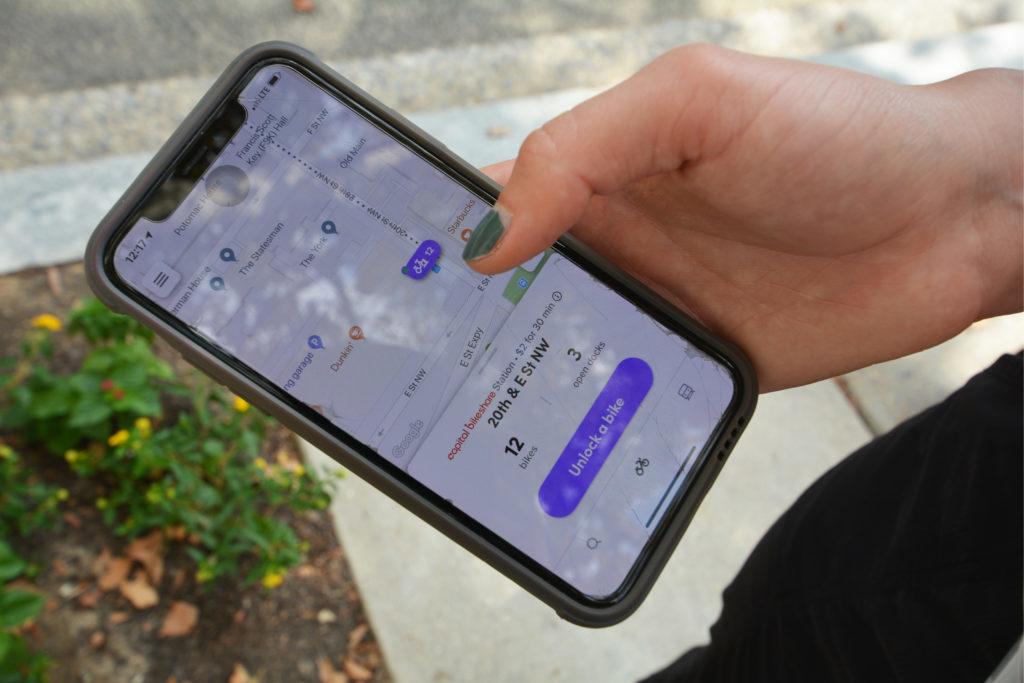Lyft users in the District can now use the company’s app to find nearby bike lanes and map out routes, the company announced last week.
The company’s app now shows the locations of protected bike lanes as solid green lines and bike-friendly routes as dotted green lines in cities like New York and D.C. More than 10 students who bike or scooter around the city said they likely won’t use the feature because they are already familiar with safe bike routes in the District.
Caroline Samponaro – the head of Lyft’s micromobility policy, which oversees policies for bikes and scooters – said adding information about bike lanes on the app will encourage riders to utilize “two-wheeled transportation” to navigate the city.
“Each ride on a bike or scooter represents a win for the environment, congestion and a more livable city, and that’s what Lyft is all about,” Samponaro said in a statement.
Lyft operates 720 scooters throughout the District and owns Motivate, the parent company of Capital Bikeshare. Beginning this academic year, students can purchase a discounted Capital Bikeshare membership for $25.
Lyft spokeswoman Darcy Yee said Lyft has advocated for bike and scooter safety in other ways, like sending push notifications to Lyft drivers and passengers to look out for bikers and scooterists during pick-ups and drop-offs.
“As the largest bike share operator in the country, Lyft has made a series of efforts over the course of the past year to improve bike and scooter safety in cities,” Yee said in an email.
Colin Browne, the communications director for the Washington Area Bicyclist Association, said the feature will be useful to new bikers and scooterists who aren’t familiar with safe routes in the city.
“If you’ve never ridden in the city or never ridden a scooter in the city and you’re unsure of the easiest way to get to a place, that seems like a valuable thing,” Browne said.
He said the feature will become increasingly important for riders as the city builds more bike paths. The District Department of Transportation plans to build a protected bike lane running through Foggy Bottom on 20th and 21st streets in the next few years.
“Right now we have so few protected bike lanes that if the app tells you, ‘Hey look, there’s a protected bike lane, it’ll get you six blocks from where you’re going,’ that’s not very helpful,” Browne said.
In interviews, 12 students said the Lyft app updates will encourage them to bike and scooter around the District more often, but the features may not help students who already bike and are familiar with safe routes.
Lauren Bradley, a sophomore who rides her bike to the National Mall, said she was unaware of Lyft’s new feature but does not see herself using the routing features because she already knows which bike routes are safe.
“I bike because it is cheap and easy, I can’t see myself adding a whole extra step to that,” Bradley said.
Bradley said bicyclists who are new to D.C. would benefit from a digital image showing the locations of protected bike lanes, but more experienced riders will stick to using familiar, safe routes.
She added that the bike lane feature will aid new bicyclists, but the main issue D.C. bikers face is the lack of protected bike lanes on District streets. She said the 23rd Street lane, which is closed because of GW Hillel construction, has made her journey to the National Mall more difficult because she has to navigate vehicular traffic.
“Drivers are not very accommodating, but I guess this just brings us back to the bike lane conversation in the first place,” she said.
DJ Davis, a sophomore who rides scooters to class, said the feature would improve bicyclist and pedestrian safety because the feature gives them information about where they can bike and walk.
“Even as a pedestrian, sometimes I don’t know where the bike lane is, and I feel like it could help the riders be more conscious,” Davis said.
Nick Sawaf, a sophomore, said Lyft’s new feature will push him to bike and scooter around the city more often, as he’s been hesitant to ride on unmarked roadways.
“For me, the problem with the current state of bikes and scooters, especially in the D.C. area, is that there are not many clear, safe routes that are meant for riders around the city,” Sawaf said. “Lyft’s new feature makes me feel way more comfortable knowing that I could ride without the fear of having to avoid pedestrians and fast-moving traffic.”





